A-Z of Literacy
Bring a little bit of creativity and play to helping your child learn their ABCs; and their D-Zees.
Sound and Letter Hunt – Megan Morgan
Decide which phonics sounds or letters you want to hunt for, hunt around your home or your neighbourhood and look out for the letter or sound!
Learning Intentions:
Identifying syllables and phonemes
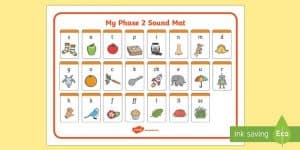 Activity:
Activity:
1. Decide which phonics sound or letter you want to hunt for. For example, you could hunt for the letter ‘a’, or the phonics sound ‘ck’. If you know which phonics sounds your child is working on in school, you could use these as a basis.
2. Go on a hunt around your home or around neighbourhood and see if you can find things that begin with or include that letter or sound. If you’re searching for the letter ‘a’ you might find an ‘ant’ outside, if you’re searching for the phonics sound ‘ck’ you might find a ‘brick’. This is a great opportunity to discuss sounds with your child.
3. Take a photo of what you find!
Activity Extension:
You could print your photographs or use a computer to label your photographs. If you search for more than one letter or sound you could get your child to sort the pictures into the different sounds!
This an example of a phonics mat you can look up online to get an idea of some letters or sounds to search for. Just search ‘phonics sound mat’ on Google images.
Making a Home for Tyrannosaurus Drip – Mairead McElroy
For those children that wish to celebrate differences or have a curiosity about dinosaurs, this story of Tyrannosaurus drip will encourage that! Snuggle up to this funny story and encourage children to design and label a new home for the main character.
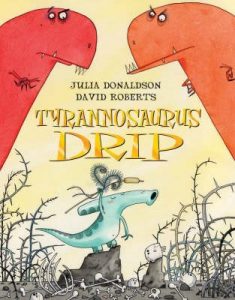 Resources:
Resources:
- Labels/post-it notes.
- Mark making materials- pencils, pens, markers, crayons, paint.
Learning Intention:
- Develop listening and attention skills to identify words in phrases and sentences.
- Building our word vocabulary through labelling or pictures of the home for Tyrannosaurus Drip.
Activity:
- Allow the children to become familiar with the story Tyrannosaurus Drip via YouTube
- After the story encourage children to design a new home for the main character of the story.
- Their supplies do not have to be restricted to mark making materials they could also use recyclable materials to create junk art, lego, or natural materials outside and create the home on a larger scale.
- Support children along the way about what they might need for their home based on the story. For example, juicy water weeds, river, swamp, nest, plants.
- Once completed encourage the children to talk about the home they have created for Tyrannosaurus.
Progression/Follow up Activities:
- If children show more interest in the activity, they could be encouraged to use post-it notes to label the different parts of the home (the adult could write down all the different parts described by the child in a big word bank and your child could copy these onto their own labels).
- Use 3D Google animals- type in dinosaur, click on view in 3D and this will create a virtual dinosaur in your own home! Children can take photos or videos if they have created a home on a larger scale through junk art or natural materials.
Match The Sound! – Eirinn McCrudden
Learn letters and find objects to match the sound!
Learning Intention:
Listening and responding to adults
Ask and answer questions to give information and demonstrate understanding
Activity:
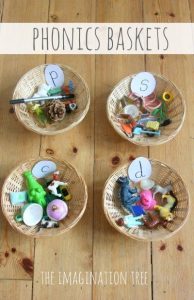 1 .Before beginning the activity, recap with your child the letters they have already learned in school (may only be SATPIN or could be more!). To recap, go over what letter it is, the sound it makes and how to write it (see letter formation sheet to left).
1 .Before beginning the activity, recap with your child the letters they have already learned in school (may only be SATPIN or could be more!). To recap, go over what letter it is, the sound it makes and how to write it (see letter formation sheet to left).
2. Once your child has a good understanding of the different letters and their sounds, explain the task to them. Their job is to go around your home to find items that begin with the sound of a certain letter that will be in their sound box (any container you have will work for this), but they only have 2 minutes to find things! EG: if the letter in their box is p, they could go and find a pencil, pen, peg, maybe a toy penguin!
3. Ask the child to write a letter on a sticky note or small piece of paper (if they are unable you can write it for them) to use as a label for their sound box, as this will act as a guide for the child to remind them of the letter. You could recap what the letter is and its sound before they leave to find items.
4. While they are off finding items, let them know that you will set a timer, so the child knows when time is up and to come back to you to check what they found. When they come back to show you their sound box, talk through the different items and ask your child to explain why they chose the items. (Be sure to praise your child for their effort and if/when they correctly match an item to a sound!)
Extension: To continue practicing their letters in a fun, sensory activity, they could write in shaving foam! Add some shaving foam to a large container/tray and let your child practice their writing! (See image to right) They could practice letters or high frequency words, EG: sat, pit, tap, in, at, is, as (more can be found online!).
NAME CREATIONS – Lindelle McCrory
An opportunity to be creative and use food/paint to replicate the child’s name.
Learning Intention
Recognise their own name and letters within it.
Resources
Sheet of paper/card, pen, raisins, Cheerios, a variety of coloured paint, paper plate and cotton buds.
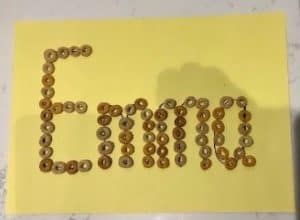 Activity
Activity
1. The adult can write the child’s name/surname on a piece of paper/card.
2. The child can then choose from a variety of items such as raisins, Cheerios or paint and decide how they would like to recreate their own name.
3. Display their finished product proudly or take a picture.
Fossil Letter Hunt – Mairead McElroy
Children are going to be encouraged to use their imagination as Paleontologists in exploring lettered fossils and matching them with the appropriate letter and sound.
Learning Intentions:
- Gain an understanding of the alphabet
- Identify and manipulate phonemes (focus could be made on the letters and sounds children are learning in school).
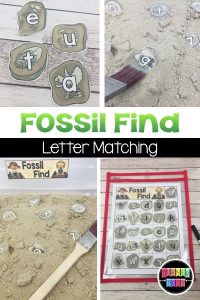 Resources:
Resources:
- Shallow container/tray/cupcake tin.
- Paint brush.
- Rice Crispies or any cereal blended, lentils, salt or flour (the idea is to resemble sand but whatever is available at home will work- children’s imaginary minds will take them anywhere!)
Activity:
- On an A4 page draw the letters of the alphabet. This will be your recording sheet.
- Using post-its or A4 paper draw the letters of the alphabet with a fossil shaped circle around them (this could be decorated in a way by the children to look like dinosaur fossils or a printable version of this is available online).
- Children could also be invited to cut out the fossil letters individually (supporting scissor skills).
- Hide the fossil letters in a shallow tray of some kind with your sand like substance ensuring the letters are hidden.
- As a warmup you could call out the letter you would like the child to find and encourage them to match it onto your recording sheet.
- You could also call out the letter you would like the child to find and they could try and identify the sound independently before they match it.
- You could progress to sounding out the letter you would like the child to find and this time when they find it, they sound it out as they place it onto their recording sheet.
Progression/Follow up activity:
- Encourage children to make basic CVC words (consonant vowel consonant- sat, mat, jam, man etc.) with the letters they find if you feel they want more challenge.
Create your own Story Cave– Louise Orr
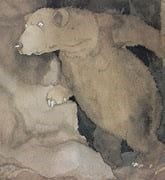 Learning Intention
Learning Intention
Encourage your child to listen to the story ‘We’re Going on a Bear Hunt’ and help them to become actively engaged in taking on character roles and act to retell each part of the story.
Activity
1. You may already have this book but if not you can use the link provided to connect to the story. https://youtu.be/0gyI6ykDwds
2. To create your own cave you will simply need a blanket and some kind of support such as a clothes drier or two chairs. You may want to read to your child outdoors for this one or create your own story cave indoors.
3. Join in acting out parts of the story with your child using any household props to support your activity. For example a teddy bear, blankets, binoculars, hats, if outdoors you might find a puddle to splash in. Your child may want to get creative and make their own props.
4. Most importantly keep it simple, fun and engaging for your child, following their lead as much as possible.
Top Letters – Colleen Megarry
This bottle lid letter game is an excellent fun way to relax and enjoy matching and sounding letters whilst competing against yourself to cover the board.
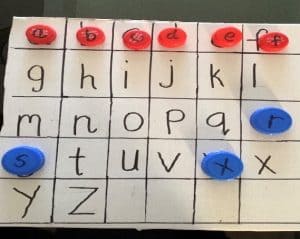 Learning Intention
Learning Intention
To recognise alphabetical letters, whilst also reinforcing the connection between letters and sounds.
Resources
26 bottle lids or pieces of paper with letters and one large piece of cardboard or paper with letters A-Z in alphabetical order,
(YouTube for Kids) Super Simple Alphabet Songs: https://www.youtube.com/watch?v=vD98OvvDNEs
(YouTube for Kids) Alphablocks # Phonics # Learn to Read: https://www.youtube.com/watch?v=U3igMJMufl8
Activity
1. Get familiar with the letter names by watching and singing along to the Super Simple Alphabet song on (YouTube for Kids).
2. Then practise matching up the bottle lids to the letters on the board. Try to complete full rows until able to recognise all letters on the board.
3. When confident recognising and saying the letter names, then make the connection with letter sounds. Watch Alphablocks Phonics (see above) to help reinforce phonic letter sounds.
4 Match up a bottle lid with a letter on the cardboard and say the letter sound. Again try to complete full rows while practicing towards all letters.
5. At times join the child in play by using a different colour of lid. Turn the lids over and take turns choosing. Win a spot on the board by saying the letter name and sound. At the end then see who has the most lids on the board.
Letter Writing – Louise Orr
Learning Intention
Develop the recognition of letter forms, by drawing the first letter of their name in a tray of rice, flour or oats using their finger.
Resources
You will need a tray and some rice (this can also be done using oats or flour).
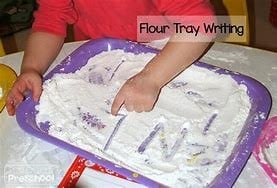 Activity
Activity
1. Cover the surface of the tray with rice.
2. Allow time for your child to explore the texture of the rice with their hands.
3. Encourage your child to draw their letter using their finger, by modelling the idea.
4. If the child can do this easily then extend further by writing their name.
Alphabet Stones – Lauren Presho
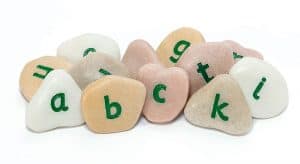 A great way to practise letter formation and play simple spelling or phonic games using stones they gather.
A great way to practise letter formation and play simple spelling or phonic games using stones they gather.
Learning Intentions
Identify and write letters; identify phonemes; and use phonemes to spell simple CVC words (consonant, vowel, consonant).
Activity
1. Resources: stones/pebbles, paint or sharpies
2. Go on a walk to collect stones, making sure the stones are big enough to write on.
3. Wash and dry the stones.
4. Using paint, or a sharpie, write different letters on the stones. If the child is younger then write the letters for them to copy. Younger children could play a simple game of retrieving the letters you call out as fast as they can. Or hide the stones so that the child can go on a scavenger hunt.
5. Foundation Stage children could play the same game except using the phonemes (sounds) for each letter. They could also try to make simple CVC words with the letter stones. You can find visuals of CVC words on google or simply call them out.
6. Key Stage 1 children could use the letters to make more complex words, seeing what the longest word they can make is and writing down all their results.
Label it! – Oonagh McLaughlin
Learning Intentions
To build up a child’s vocabulary bank
Activity
1. Using a list of home related vocabulary, label items throughout the house.
2. Challenge your child to match the labels, either pictorially or by using their phonics to sound out the vocabulary.
3. This activity would also be suitable for older children learning a modern language, or to introduce a new language to your child.
Camel, Cat, Dog, Dolphin – Aimee McGleenon
From carrot to cow, dinosaur to digger I spy something beginning with …….
Learning Intentions:
To become more familiar with the letters c and d
To become aware of their accompanying sounds, developing phonetic awareness of letters c and d
Activity
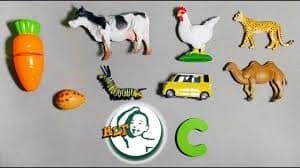 1. Collect some items that start with the letters c or d and bring them all together on the floor or at a table.
1. Collect some items that start with the letters c or d and bring them all together on the floor or at a table.
2. Pick someone to take the first turn (adult but alternate).
3. Choose one of the items and say, ‘I spy with my little eye, 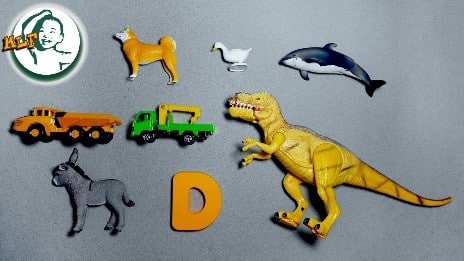 something beginning with… c/d.’ Make the sound for the letter too.
something beginning with… c/d.’ Make the sound for the letter too.
4. Ask the other person to guess and say the name of an item and the sound for the starting letter.
5. Remove each item as you use them and make two piles. One for C words and one for D words.
6. Place the items in the correct pile when you are finished with it.
7. Keep playing until all items are organised into the piles.
Listening and Recall – Aimee McGleenon
Learning Intentions:
To develop listening and recall skills when following a story
To continue development of phonetic awareness of letters c and d
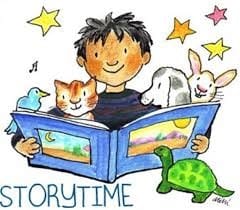 Activity:
Activity:
1. Pick a book to read together with an adult at home.
2. Find a cosy spot where you can read the story. If you have some cushions and blankets you could make a fort or tent.
3. When you are ready, start your storybook.
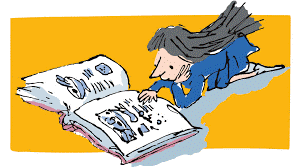 4. Listen to what is happening in the story.
4. Listen to what is happening in the story.
5. Look at what is happening in the pictures or illustrations.
6. Can you spy any words you know? Can you spy any words that begin with C or D?
7. If you have found some, make a list of the words and say them as you write them.
